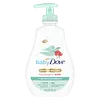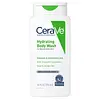What's inside
What's inside
 Key Ingredients
Key Ingredients

No key ingredients
 Benefits
Benefits

 Concerns
Concerns

 Ingredients Side-by-side
Ingredients Side-by-side

Water
Skin ConditioningCocamidopropyl Betaine
CleansingPetrolatum
EmollientLauric Acid
CleansingSodium Cocoyl Glycinate
CleansingGlycerin
HumectantGlycine Soja Oil
EmollientUrea
BufferingStearic Acid
CleansingSodium Cocoyl Isethionate
CleansingSodium Hydroxypropyl Starch Phosphate
AbrasiveSodium Lauroamphoacetate
CleansingSodium Methyl Cocoyl Taurate
CleansingSodium Chloride
MaskingCeramide 3
Skin ConditioningCeramide 6 Ii
Skin ConditioningCeramide 1
Skin ConditioningHyaluronic Acid
HumectantPhenoxyethanol
PreservativeGuar Hydroxypropyltrimonium Chloride
Skin ConditioningSodium Hydroxide
BufferingSodium PCA
HumectantOphiopogon Japonicus Root Extract
Skin ConditioningTetrasodium EDTA
Ethylhexylglycerin
Skin ConditioningSodium Lauroyl Lactylate
EmulsifyingPhytosphingosine
Skin ConditioningCholesterol
EmollientCarbomer
Emulsion StabilisingXanthan Gum
EmulsifyingWater, Cocamidopropyl Betaine, Petrolatum, Lauric Acid, Sodium Cocoyl Glycinate, Glycerin, Glycine Soja Oil, Urea, Stearic Acid, Sodium Cocoyl Isethionate, Sodium Hydroxypropyl Starch Phosphate, Sodium Lauroamphoacetate, Sodium Methyl Cocoyl Taurate, Sodium Chloride, Ceramide 3, Ceramide 6 Ii, Ceramide 1, Hyaluronic Acid, Phenoxyethanol, Guar Hydroxypropyltrimonium Chloride, Sodium Hydroxide, Sodium PCA, Ophiopogon Japonicus Root Extract, Tetrasodium EDTA, Ethylhexylglycerin, Sodium Lauroyl Lactylate, Phytosphingosine, Cholesterol, Carbomer, Xanthan Gum
 Reviews
Reviews

Ingredients Explained
These ingredients are found in both products.
Ingredients higher up in an ingredient list are typically present in a larger amount.
Cocamidopropyl Betaine is a fatty acid created by mixing similar compounds in coconut oil and dimethylaminopropylamine, a compound with two amino groups.
This ingredient is a surfactant and cleanser. It helps gather the dirt, pollutants, and other impurities in your skin to be washed away. It also helps thicken a product and make the texture more creamy.
Being created from coconut oil means Cocamidopropyl Betaine is hydrating for the skin.
While Cocamidopropyl Betaine was believed to be an allergen, a study from 2012 disproved this. It found two compounds in unpure Cocamidopropyl Betaine to be the irritants: aminoamide and 3-dimethylaminopropylamine. High-grade and pure Cocamidopropyl Betaine did not induce allergic reactions during this study.
Learn more about Cocamidopropyl BetaineGlycerin is already naturally found in your skin. It helps moisturize and protect your skin.
A study from 2016 found glycerin to be more effective as a humectant than AHAs and hyaluronic acid.
As a humectant, it helps the skin stay hydrated by pulling moisture to your skin. The low molecular weight of glycerin allows it to pull moisture into the deeper layers of your skin.
Hydrated skin improves your skin barrier; Your skin barrier helps protect against irritants and bacteria.
Glycerin has also been found to have antimicrobial and antiviral properties. Due to these properties, glycerin is often used in wound and burn treatments.
In cosmetics, glycerin is usually derived from plants such as soybean or palm. However, it can also be sourced from animals, such as tallow or animal fat.
This ingredient is organic, colorless, odorless, and non-toxic.
Glycerin is the name for this ingredient in American English. British English uses Glycerol/Glycerine.
Learn more about GlycerinStearic Acid is a fatty acid. It is an emollient, emulsifier, and texture enhancer.
As an emollient, stearic acid helps soften skin. It aids the skin's protective barrier by preventing water loss. It also provides a gentle cleansing effect without stripping away natural oils.
Stearic acid may also be used to enhance the texture of products. It can add volume and stabilize ingredients such as water and oil. This can help water and oil ingredients from separating.
Sources of stearic acid include animal or vegetable fats/oils such as coconut or shea. It can be naturally found in butter, cocoa butter, shea butter, vegetable fats, and animal tallow.
This ingredient may not be Malassezia folliculitis, or fungal-acne safe.
Learn more about Stearic AcidTetrasodium EDTA is the salt formed from neutralizing ethylenediamine tetraacetic acid with sodium hydroxide. It is a chelating agent and used to prevent metal ions from binding to other ingredients. This helps keep the product and ingredients stable.
Tetrasodium EDTA comes as a white solid and is soluble in water.
Water. It's the most common cosmetic ingredient of all. You'll usually see it at the top of ingredient lists, meaning that it makes up the largest part of the product.
So why is it so popular? Water most often acts as a solvent - this means that it helps dissolve other ingredients into the formulation.
You'll also recognize water as that liquid we all need to stay alive. If you see this, drink a glass of water. Stay hydrated!
Learn more about Water